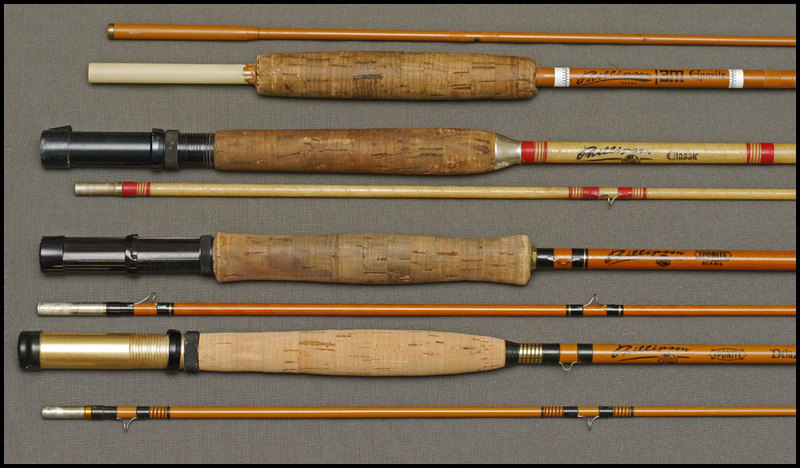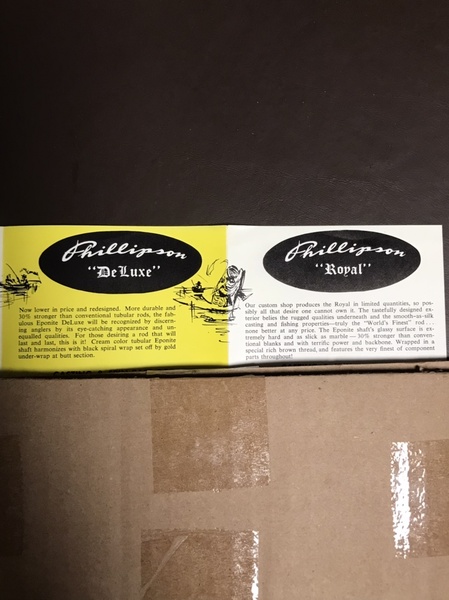Good morning to all the Phillipson Fiend Club members out here.
What I’m about to say is sure to cause some fuss ..
For many years it has been opined on this site that the Phillipson “Mylar” Masters were based on Eponite blanks .
I’ve disagreed with this assessment for about as many years…
I lurked on this forum for a solid decade before i joined.
Since officially joining back in 2018 I’ve kept my trap shut about it since it was only a hunch at the time.
I’ve been trying to get some reference material to make my case.

I think 13 8ft 6/7wt Phillipson rods should help get us a proper frame of reference..
The lynch pin for my hypothesis was to finally score an 8ft Mylar Master rod .

Check..
Here’s my evidence
The Mylar Master M80 arrived over the weekend and as soon as I took it out of the box cleaned the ferrule and wiggle tested it.
I could tell right away it was not an Eponite rod..
Eponites just have a certain “spring” to them.
Eponites feel heavier but have a smaller wall diameter than its 6wt Classic glass equivalent.
This 8ftr was just like my 7.5ft and my 8.6ft Mylar Master in that it’s
Lacking the spring and the back bone of my Eponites
I could also tell Just by eye it had a bigger diam than my Eponites
So I got out all my rods to confirm
The Mylar Master ferrule is bigger than my Eponites see pics


The Mylar Master has the same ferrule and the same same taper as my Classic Glass 8ft scout,chieftain,regal lancer



Did a quick “unscientific” measurement
My Classic glass rods and the Mylar Master within acceptable tolerance as the the chief and the master we’re almost identical
The scout was on the low end but feels slightly softer is not painted or dipped and I believe is an earlier rod so that stands to reason for it being thinner
The regal lancer is painted and has been dipped a few times so it is thicker there .
All in all the same.




My 8ft Eponites p80 and x80 were definitely thinner


Here is my Eponite dry fly special which has a 7wt butt with 6wt tip


With the Royal being even a bit thinner .
I remember Professor Bulldog saying royals were always hand picked for lightness and crispness along with aesthetics..
So on taper and ferrule the Mylar master is based on the classic glass rods .
On action.
The Mylar Master and the Chieftain feel super close to one another.
The scout feels a lil different since it has spin tip top that seems to be original. Slightly lighter action but with more tip bounce .
The Regal Lancer has one extra guide fancy wraps and been dipped a few so it naturally is a lil more slow action.. but a smooth operator.
Let’s talk about finish
Here are some pics




At a first glance I could see who one my think it’s an Eponite but look closely.
Eponites have a certain “grain” to them. See how the scrim has like small rectangular dashes running lengthwise up the blank
The Mylar Master and The Scout have a scrim that’s that’s like a stacked squares/weave
You can tell that the Eponites are “harder” and are just a tad more shiny.
Well if its not Eponite ? What is it??
The 1961 mini-catalog gives us some insight

As the back of the catalog states that by 61
Phillipson changed from phenolic to epoxy for all rod construction .
So the later “classic” glass rods are upgraded from phenolic to epoxy but not vacuum/cured like Eponites.
The scrim was slightly different but the prepregs and resins were most likely similar .
Like it was Bill’s swan song for the Classic glass customer base..
Those who wanted bamboo like action of the older tapers but built to last.
But maybe not last as well as an Eponite .lol

Here is more evidence from the 61mini catalog
Introducing “classic” glass rods.

Here’s the Mylar Master entry
Notice no mention of the the master being built on Eponite blanks . Just saying natural tone tubular blank.
If masters were Eponites no doubt they would have touted that fact in the listing.

Moving up the food chain in the 61 catalog here is the de luxe rods entry specifically mentions that it’s built on a new and improved Eponite Blank.

And finally the top spec Royal’s entry
once again specifically mentioning Eponite Construction ,Also mentioning hard and slick as marble..

Here’s a mention from the 58-59 catalog announcing the improvement of Eponite

Back cover shot of Bill putting the Eponite to the test on The Gunnison

I’ll let you rod detectives peep my evidence and see if I’ve got a case or not??
Addendum..
I ran a wiggle test on my 7.5ft phillipson Mylar master compared to my R76,t76, and the Profile 400/Eponite rod I’ve got about 1,500 casts in with this week .
The 7.5 Mylar Master is way more akin to ratface’s r76 and my powerkast T76
Than it is to carlZ old Eponite profile 400 I picked up recently.
It’s Not even close.
Also my Mylar Master 7.6 and 8.6 have the same scrim and finish as the 8footer .
Not trying to ruffle any feathers but I wanted to share this important info with y’all .
Older phillipson rods get generalized and mischaracterized a whole bunch around these parts.
I kinda bums me out that in all these years that those generalizations keep getting echoed..
It’s not tobacco glass , it’s not trevarno glass
It’s Phillipson “Classic” glass
Approx Timeline I work from
Gen-1 Phenolic
scripted rods-1951-54
challenger,special and original DeLuxe rods 54-55-56?
Gen-2 improved Phenolic
S-series, R-series, PowerKast/T-series 55-57? Better scrim and phenolic prepreg as earlier rods.
I hypothesize that Scouts, Lancers ,chieftains and stream knights were possibly built on the gen2 phenolic and gen3 epoxy process
The scouts,chiefs,lancers,and knights are all in my 58-59 catalog so they are cataloged much more late in the game than others thought.
Many on the site think those rods are early to mid 50s rods .
58-59 That puts them just in time for when all rod production was moving to epoxy .
Gen3 would be the rods labeled
“Classic”
utilizing epoxy construction without high pressure
I sure hope Dr Todd reads this…
I’d like to know what he thinks
ok I’m ready for the slings and arrows to begin…
Go!













































































